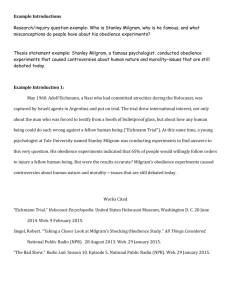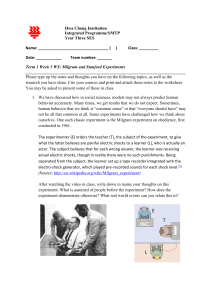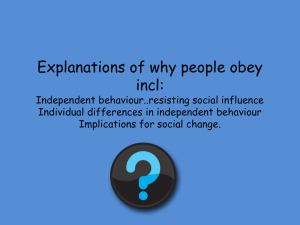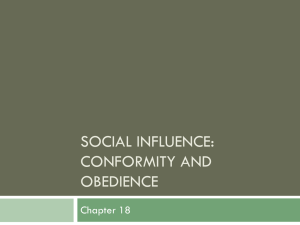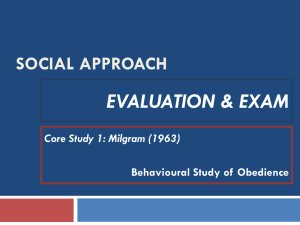Individual Essay 2
advertisement
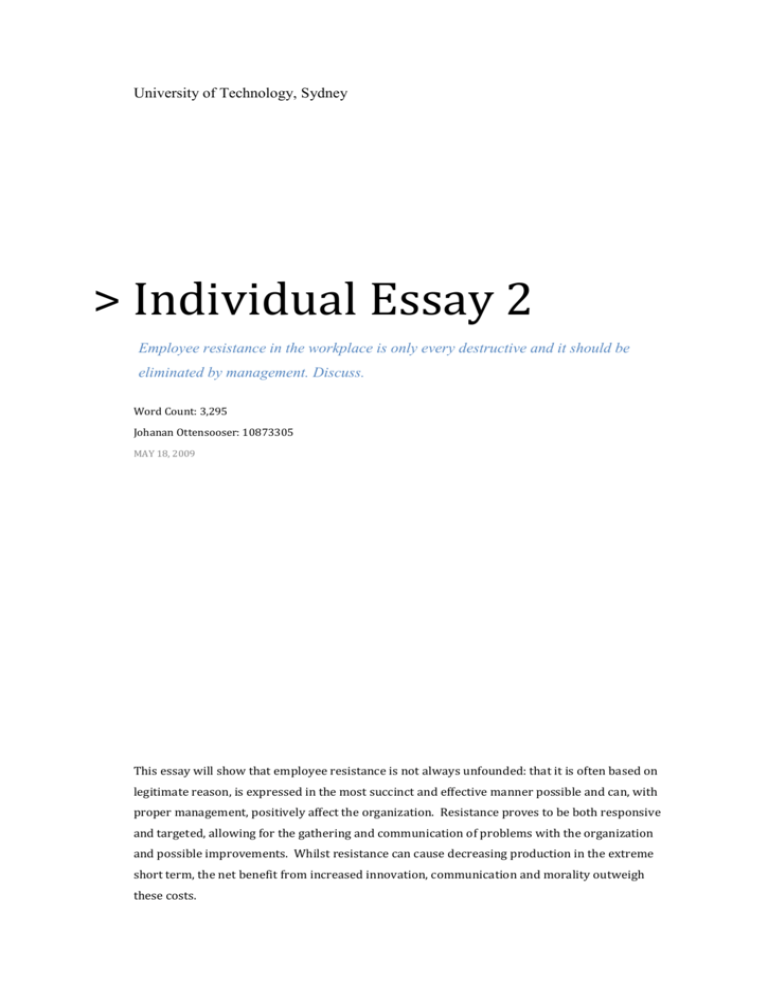
University of Technology, Sydney > Individual Essay 2 Employee resistance in the workplace is only every destructive and it should be eliminated by management. Discuss. Word Count: 3,295 Johanan Ottensooser: 10873305 MAY 18, 2009 This essay will show that employee resistance is not always unfounded: that it is often based on legitimate reason, is expressed in the most succinct and effective manner possible and can, with proper management, positively affect the organization. Resistance proves to be both responsive and targeted, allowing for the gathering and communication of problems with the organization and possible improvements. Whilst resistance can cause decreasing production in the extreme short term, the net benefit from increased innovation, communication and morality outweigh these costs. Individual Essay 2: Option 4 2009 Introduction: According to Taylor, the “awkward, inefficient, or ill-directed movements of men” caused the inefficiencies of production (Taylor, 1911, p. 1). This thought crystallises the managerial zeitgeist from the industrial revolution until the mid twentieth century; the employee a set of “hands” (Water-Foot Mill, 1851), with all dissent being counter-productive. In turn, this demonises resistance in a simplistic manner, without factoring in potential for resistance as constructive, rather than destructive. Modern management theory has criticised the simplicity of the classical treatment of resistance, stating that it can be beneficial to organisations if harnessed properly. This essay will discuss resistance triply: Section 1 will analyse the reasons for, and methods of resistance in the workplace (Milgram, 1974; Waddell & Sohal, 1998). Section 2 will discuss the negative and positive effects of resistance (Taylor, 1911; Milgram, 1974; Deming, 1982; Rudge, 1990). Section 3 will analyses several managerial practices regarding resistance (Rudge, 1990; Mydans, 2009). Through the above, this essay will show that resistance is not necessarily destructive, and that, at times, it is inappropriate for management to eliminate dissent. 2/20 Johanan (Yochi) Ottensooser 10873305 Individual Essay 2: Option 4 2009 Section 1: Why and how employees resist Employee resistance is contra to the persistent management theory of unitarism: the belief in organizations being wholly unchallenged. However, it is clearly representative of the problem of agency: the employer requires the greatest labour for the least pay; the employee wants the least work for the greatest pay. In order to bridge this gap, management is required to apply certain pressures, in the form of management techniques, to increase employee productivity without sacrificing economy. These artificial pressures include quotas, scrutiny1 and commission as well the institutionalised corporate culture and ethic, with these pressures stimulating resistance. This section will analyse two key frames of resistance analysis, a causal analysis posed by Milgram (1974) and a functional analysis posed by Waddell and Sohal (1998), as well as classifying them by their mode of expression and magnitude. These pressures, when analysed individually, allow for a causational flow from management to employee to resistance. However, this analysis would be simplistic, since it does not account for external pressures, or the factors working to stop an employee from resisting. Milgram (1974, pp. 132-164) suggests analysis through a balanced flow chart; involving the inputs of Binding Factors and Antecedent Conditions in creating the Agentic State2, an equilibrium threatened by the Strain of obedience (see Figure 1). It is important, here, to define each keyword: a task made easier by applying them to a case study, such as McIlvanney’s “The Prisoner” (1989), a short story about a prisoner, McQueen, rebelling against the prison and authority. Antecedent conditions are those historical factors which allow the “agent” to be bound to authority: in this case, McQueen’s upbringing in a familial organisation, his (societally) engrained sense of deference to uniform (the prison guards), and others. Binding factors are those on which current obedience is reliant: in “The Prisoner”, the fear of punishment, respect for the Warden, (especially his consistent authority) and the want for freedom (which only the Warden/the authority can grant). However, in this case, the “strain” accumulated by consistent obedience dwarfed the antecedent and binding conditions, which Especially in the Taylorist frame, which works on “observable operational modes and ‘standard’ work rates”, not to mention being largely enforceable through scrutiny alone (Peaucelle, 2000, p. 455). 2 A dissociative ethical state with almost complete obedience 1 3/20 Johanan (Yochi) Ottensooser 10873305 Individual Essay 2: Option 4 2009 Start Primary Conditions for Obedience Antecedent Conditions (A) Binding Factors (B) The Agentic Cycle Agentic State Obedient Action A+B>C Strain (C) Consequence A+B<C Dissent A+B<C Breaking the Agentic Cycle Resolution of Strain A+B<<C Disobedience End Figure 1 - Obedience and Disobedience in the Agentic Cycle (Based on Milgram, 1974, p 154) 4/20 Johanan (Yochi) Ottensooser 10873305 Individual Essay 2: Option 4 2009 lead first to dissent, and then to complete, calculated disobedience. The “strain” is unlike binding and antecedent conditions, since it “shows not the power of authority, but its weakness” (Milgram, 1974, p. 154): for McQueen, it is a building sense of purposelessness and lack of control caused by intense micromanagement and intense deprecation. These, in turn, outweigh McQueen’s proclivity to obedience (antecedent conditions), his respect for the warden, and his fear of punishment (binding factors). Milgram then suggests that the “Agentic state” of obedience is shattered, and that a “resolution of strain” (Milgram, 1974, p. 157) is required. He suggests many forms of resistance that serve this purpose, including, most importantly, dissent3 and disobedience4. In the case of McQueen, it is clear that direct dissent, as well as disobedience occurs, as shown in the extract below. “McQueen. You were obviously unhappy throughout the Christmas meal. Officer Roberts warned you three times ... and what did you do? At the end of the meal ... You jumped on to the table and danced through all the other empty plates ...” (McIlvanney, 1989, p. 59) The act of resistance is overt and apparently simplistic. However, as a physical act of self-humiliation and destruction, it served to vent the “strain” of obedience by exaggerating the humiliation that is required by the organization, as well as individuating the prisoner. In turn, this prisoner broke the binding factor of the Warder’s authority. Finally, in this case, McQueen, through resistance, was able to negate hierarchy, and speak to the Warder on equal terms, allowing for better communication. Milgram allows for a causal analysis of resistance, deconstructing the factors that allow for obedience and require resistance. Weddell & Sohal (1998) analyse resistance by its prospective function. Strategic Direction (2002) surmises this theory succinctly: with rational, non-rational, political and managerial functions served by resistance (Strategic Direction, 2002, p. 21). Again, a proper explanation of this theory requires its application. 3 4 Resistance within the allowable frame of the organisation Entirely resisting authority either through inaction or direct conflict 5/20 Johanan (Yochi) Ottensooser 10873305 Individual Essay 2: Option 4 2009 This theory states that resistance occurs for a purpose, and is not solely a reaction to pressures. Rational resistance seeks to highlight a flaw or offer a suggestion in an organisation. Non-rational resistance is a product of binding conditions: an unwillingness to change away from the familiar. Political resistance attempts to “score points” against equals or superiors. Finally, management resistance attempts to highlight flaws in the managerial process or status quo (Strategic Direction, 2002, p. 21). In the case of McQueen, it is clear that he has reason to be dissatisfied. Weddell & Sohal (1998, pp. 434-435) posit that dissatisfaction is not reason enough for true resistance, but would only cause dissent. McQueen’s actions, however, are purposeful, with rational, political and management goals. His resistance is functional and calculated: “‘You ate the pudding. You ate everything. And then you made your protest. Why?’... ‘Ah was hungry, sur,’” (McIlvanney, 1989, p. 65) Unlike an uncalculated and reactive resistance, this was delayed and planned. Here, resistance is a rational critique of management, suggesting that, not only are conditions bad, there is a communications flaw that traces back to management. McIlvanney accentuates this with a blatant criticism the lack of communication between the prisoners and the management, between whom there are no accessible direct speech channels or intermediaries “‘you said it yerself, sur. Ye can’t complain to the waiter, can ye?’” (McIlvanney, 1989, p. 64). A functional analysis of McQueen’s actions highlights that resistance is not reactionary, but, rather, often planned. Thus far, this essay has analysed the causal and functional reasons for resistance in the workforce. However, the method of resistance is also quite important. The dominant factors in classifying resistance are its compliance with the organisation’s ethical, social and legal frames and its effect in creating new spheres of influence. To analyse the medium of employee resistance, three case studies must be analysed: McIlvanney’s story (1989), Rosen’s critique of corporate culture through the corporate Christmas party (1988) and an analysis of the English slaughtermen (Akroyd & Crowdy, 1990). 6/20 Johanan (Yochi) Ottensooser 10873305 Individual Essay 2: Option 4 2009 In “The Prisoner” (McIlvanney, 1989), there are two forms of resistance, one overt and the other covert: the original ruckus in the Christmas dining hall and the following conversation with the Governor. The first form of rebellion is explicitly anti-establishment, deliberately subverting organizational rules. However, this facilitates his discussion with the Warder, a legitimate for of resistance, where he expresses his dissatisfaction to the highest authority in the organisation. In Rosen’s analysis of the corporate Christmas party (1988), there is a sterling example of institutionalised dissent, creating a “steam valve effect”5. Here, Rosen quotes Turner (1974) in stating that hierarchy “is all that holds people apart, defines their differences, and constrains their actions” (Turner, 1974, p. 54), implying that the organization is well aware of the Strain caused by their hierarchy. To counter this, management allows the employees to subvert social order in the organised and institutionalised form of Christmas party skits. This is in contrast to the case of the English slaughtermen (Akroyd & Crowdy, 1990), whereby resistance is in response to sub-normal working conditions, as well as the societally stigmatised nature of their work. Here, whilst their actions6 are morally repugnant and illegal, they are within the organisational framework7. This creates a sense of camaraderie, which solidifies the group as a separate organization, creating a group power rivalling the organization: “the spontaneous formation ... of occupational cultures” with a “strong internal hierarchy” (Akroyd & Crowdy, 1990, pp. 4, 6). Thus, the English slaughterman are dissenting, creating a new group-power. Thus, a classification of resistance through its methods is applicable: whether it is dissent (within the organisational frame) or disobedience, and whether it is individual or en mass. Section 1 has elicited four central points. Firstly, that resistance reflects the health of management and the concerns of the employee. Secondly, that resistance can be functional; a 5 In Figure 1, this effect is as an institutionalized Dissent, allowing for expression of Strain within the organisational framework, relieving Strain and returning the subject to the Agentic Cycle. 6 Throwing guts across the room, filling workmate’s shoes with blood, etc. (Akroyd & Crowdy, 1990, pp. 5-8) 7 “[Management allowed for] a distinctly occupational, not organisational, culture” (Akroyd & Crowdy, 1990, p. 4) 7/20 Johanan (Yochi) Ottensooser 10873305 Individual Essay 2: Option 4 2009 form of communication between the employee and management reflecting concerns, fears or internal politics. Thirdly, that when resistance occurs, it happens first through the allowable frame (dissent), and, in the extreme, outside the regulation of the organization (disobedience). Finally, that resistance can be individual, or (as a greater threat to management) derive its power from the pack mentality and numerical advantage of groups. 8/20 Johanan (Yochi) Ottensooser 10873305 Individual Essay 2: Option 4 2009 Section 2: The effects of resistance The dilemma for management arises not in the cause or motivation for resistance, but in its effects. Classical management theory, represented by “Fordism8”, stipulates a Unitarist approach to management, that is, the requirement for complete solidarity within organisations. In deriving this, the Unitarists highlight the negative effects of resistance. However, contemporary management theorists move away from “Fordism”, towards “Toyotism”9 (Peaucelle, 2000): requiring the acceptance of resistance as inevitable, manageable and possibly beneficial. It is critical to discuss positive and negative effects of resistance on an organisation. The theories of Taylor (1911), Milgram (1974) and Ackoff (1994) provide a frame for the analysis of the negative effects of resistance. Taylor’s analysis is superficial, regarding resistance as a reduction in productivity. Milgram’s analysis develops this, uncovering the decrease in the obedience subsequent. Finally, Ackoff suggests that resistance increases the organization’s proclivity towards management (“power over” (Ackoff, 1994, p. 112)), over leadership (“power to” (Ackoff, 1994, p. 112)). Fundamentally, Taylor’s theory of scientific management requires the detailed micromanagement of every stage of the production process. He derives productivity from this, requiring absolute efficiency in each process (Taylor, 1911, pp. 1-3). Hereby, any resistance (i.e. the “ill directed movements of men” (Taylor, 1911, p. 1)) subverts this absolute and scientific efficiency, creating a large opportunity cost for resistance that traditional managers have avoided. Milgram puts forth an additional form of inefficiency, supported both by theory (figure 1) and by experiment (Appendix 1: Table 1, [Experiment 1, 6, 15, and 17]). Here, resistance compromises the worker’s Binding Factors of respect for the authority of the manager, fear of repercussions of resistance and fear of change (of authority, of the status quo, etc.). This, in turn, reduces the forces against resistance and increases the worker’s chance of resisting. This theory supported by Milgram’s experiments, whereby the 8 The production theory involving the segmentation of the production process into deskilled, repetitive tasks on a production line 9 Like Fordism but with the increased incentive for expression by allowing each level of production to offer innovation. 9/20 Johanan (Yochi) Ottensooser 10873305 Individual Essay 2: Option 4 2009 percentage of subjects being completely obedient drops significantly in response to dissent (from 65% in Experiment 1 to 10% in Experiment 1710), contradictions or changing management. Thus, Milgram shows that resistance breeds more resistance, escalating the problems described above. Finally, Ackoff suggests that there are two primary forms of direction, “power over” being management based and “power to” being leadership based, the first more widespread, but less effective (Ackoff, 1994, p. 115). However, Ackoff also suggests that resistance breeds increased domination, in turn increasing the amount of resistance in a vicious cycle of ineffective management. Thus, whereby Ackoff does not suggest that quashing resistance is optimal, he suggests that resistance disrupts dominative workplace equilibrii. In summary, the extent of the Unitarist argument is Taylor’s opportunity cost, with Milgram and Ackoff both accounting for the accelerating nature of resistance’s ill effects. However, it is critical to note that the loss of non-financial assets (i.e. public standing, goodwill (Rothschild & Miethe, 1994)) through overt external resistance, such as industrial action, is also quite substantial. Whilst the above shows absolute and measureable costs associated with resistance, this essay will show that the positive effects of resistance outweigh them. These positive externalities of resistance include the “innovation effect” (Deming, 1982; Rudge, 1990), increasing communication (Rudge, 1990) the “steam valve effect” (Milgram, 1974), and its flow on effects (Sievers, 2006; Bakan, 2004) and the increased production associated with “volunteerism” (Milgram, 1974). In modern industry, unlike classical production, directors generally hire managers not from the ranks of workers but from university and other managerial positions. As such, workers are often more skilled in their field than their managers (Rudge, 1990, pp. 194-196, 251-255). Therefore, since workers are more skilled, it can no longer be the role of the manager to enforce a static production system. Rather, as Deming and Johnston suggest, it is the role of the manager to regulate inefficient production, set productivity and quality goals (Deming, 1982, pp. 3, 11-18) and “teach people to solve problems by [by example]” (Spear, See Appendix 1: Milgram’s Experiments for an analysis of how Milgram derived these percentages, as well as a copy of all tables referred to above. 10 10/20 Johanan (Yochi) Ottensooser 10873305 Individual Essay 2: Option 4 2009 2001, p. 3). If motivated properly, innovation is a product of resistance to current workforce practice. “engineers and chemists became innovative, creative. ... They modified the chemical content of the material used for the coating and found how to use less and less” (Deming, 1982, p. 11) Deming’s analysis of the Nashua Corporation, above, highlights the effectiveness of resistance in production, showing that resistance can have the positive externality of increased efficiency. In congruence, Rudge stipulates that within most organisational structures, communication is adjacently linear vertically11. Rudge models this as the “wheel” of organizational communication (see figure 2). In this model, the only form of multi-level communication is unilateral communication from the top level of the hierarchy. Rudge then states that resistance allows for complete multi-level communication (Rudge, 1990, pp. 210231). Furthermore, as Section 1 has shown, resistance is hardly arbitrary, and the information communicated could be invaluable. Figure 212: Wheel of Organizational Communication (Rudge, 1990, p. 216) Whereas Milgram predicted that resistance would lead to more resistance, his model also shows the positive effects of resistance as a “steam valve”, releasing pressure and angst in the organization in a relatively harmless manner. As shown in Figure 1 and the Rosen’s 11 i.e. that a level of management only talks to the level above and below it, and not the others on the same level of hierarchy 12 In this figure, lines represent communication channels. 11/20 Johanan (Yochi) Ottensooser 10873305 Individual Essay 2: Option 4 2009 analysis of the Christmas Party discussed above, low-level resistance (dissent) does not lead to the breaking of the Agentic Cycle, but rather to the reduction of Strain. Furthermore, the conditions of the Agentic State – unquestioning obedience and moral disassociation – are not always synchronised with the best interests of the organisation. Sievers and Bakan (2006, p. 104; 2004, pp. 23-27) suggest that an organization is uncontrolled13, psychotic and psychopathic14. By breaking out of the Agentic Cycle, an employee is able to evaluate the actions of the organization externally (Milgram, 1974, pp. 179-190 Epilogue). This corresponds with the “management principles” of Toyota, as highlighted below. “Principle 14: Become a learning organization through relentless reflection (hansei) and continuous improvement (kaizen).” (Brown, 2004, p. 5) Toyota has attributed much of its productive successes to this “resistance” based production, whereby employees are encouraged to reflect on the production process and the organisation from an external viewpoint (Brown, 2004, pp. 2-3). Furthermore, the employee is able to evaluate his own ideas allowing for strong decisions, without “looking up and looking around” (Jackall, 1988, pp. 75-76)15. Finally, Deming’s asserts that freedom of resistance leads to increased volunteerism (Deming, 1982, p. 3). Milgram describes this effect: “[In this case] the principle sanctions for disobedience come from within the person... [they are] not dependent upon coercion, but ... [on] the individual’ sense of commitment to his role. In this sense, there is an internalised basis for his obedience, not merely an external one”. (Milgram, 1974, p. 141) Therefore, resistance has several positive effects on the organization: innovation, communication, reduced Strain, increasing morality and volunteered, rather than enforced work ethic. Or, rather, controlled by “psychotic anxieties ... [and] unconscious fantasies” (Sievers, 2006, p. 104) As an “irresponsible ... manipulative ... grandiose” which “lacks empathy ... demonstrates anti-social tendencies ... refuses to accept responsibilities for its own actions ... [is] unable to feel remorse ... [and] relates to others only superficially” (Bakan, 2004, pp. 23-27, Chapter 2) 15 Judging decisions against the cohort rather than against their merit 13 14 12/20 Johanan (Yochi) Ottensooser 10873305 Individual Essay 2: Option 4 2009 This section has shown that there are many positive and negative effects of resistance. However, the considerable increases in productivity available through resistance outweighs the negative effects, especially since they can be controlled by allowing for official (formal) channels for dissent rather than allowing for “informal routine forms of resistance [which are]... less visible” (Prasad & Prasad, 2000, pp. 1, 2) and more difficult to control. 13/20 Johanan (Yochi) Ottensooser 10873305 Individual Essay 2: Option 4 2009 Section 3: Crushing Resistance or Harnessing Resistance The ways to deal with organisational resistance can be subdivided (Rudge, 1990, pp. 1617)16: Table 1 Charismatic (C) Judgemental Character of Intuition Classical (X) Control Process Traditional (A) Strength of tradition Degree of consciousness Purpose of Design Nonreflective Preserving status quo Unpredictable Calculated Giving effect to intuition Maximising efficiency Specific Standards set by top Management Human Relations (Y) Individual sense of responsibility; answerability to peers Articulation of feelings Maximising happiness Systemic (Z) Conscientiousness of expert; threat of non-survival Highly conscious Maximising relevance Table 1 shows different management theories’ response to resistance. The first three (A, C and X) have inflexible purposes and controlling processes, in essence disallowing resistance. As such, they are non-reflexive, unpredictable and immoral (calculated rather than empathetic) (A, C and X respectively). However, the last two theories (Y and Z) employ volunteerism and respect to reduce negative feelings within the organization, and have relatively selfless purposes. Furthermore, these two theories allow for formal dissent within the organisation, leading to increased happiness and productivity (Rudge, 1990, pp. 211-231). Discouraging resistance is much more difficult, considering its resilience. “[the resistance] was induced ... by an emotionally charged consern to preserve ... self-identity” (Ezzamel, Willmott, & Worthington, 2001) Management has to contend with the irrationality of dissent, a target much less visible or tangible than the reasons for their resistance. This difficulty in crushing dissent is consistent with the cases of revolution and insurgency. Take the example of Daw Aung San Suu Kyi, the revolutionary acting in Burma and Thailand (Mydans, 2009). Here, Burmese officials crushed Kyi’s rebellion without thought for its purpose, message or what it was 16 See Table 1, below 14/20 Johanan (Yochi) Ottensooser 10873305 Individual Essay 2: Option 4 2009 protesting. As such, more than a decade after the original revolt, the result is that she is still in the public eye. “They are trying their best to put her out of the minds of the people... [They are having] the reverse effect” (Mydans, 2009, p. 1) By ignoring her plight and crushing resistance ruthlessly, they extend her power and increase their political losses. Harnessing resistance has positive effects. Conversely, summarily crushing resistance increases the power of those who resist by antagonising their peers. Furthermore, crushing resistance is, as Burma has shown us, nigh on impossible. Misquoting Star Trek’s fictional species the Borg, resistance to resistance is, somewhat, futile (Roddenberry, 1990). 15/20 Johanan (Yochi) Ottensooser 10873305 Individual Essay 2: Option 4 2009 Conclusion: This essay was in response to the statement, “employee resistance in the workplace is only ever destructive and should be eliminated by managers”. This proves to be false. Section 1 discussed the fact that resistance is not baseless. Here, the reasons for dissent and the methods of resistance prove informative. Section 2 revealed that employee resistance is not only destructive. Whilst there were a few negative effects, they are controllable via offering official means for resistance. Finally, Section 3 evaluated differing management techniques, showing that those which embraced resistance were often more productive, as well as more open and moral. Furthermore, it highlighted the difficulty in eliminating resistance at all: if this were the goal of management, it would hardly be achievable. Therefore, resistance is not always negative. In fact, it is mostly positive. Furthermore, management should not, and could not crush it. 16/20 Johanan (Yochi) Ottensooser 10873305 Individual Essay 2: Option 4 2009 Appendix 1: the Milgram experiments In 1974, Stanley Milgram “Obedience to Authority: An Experimental View”, in which the extent of human obedience to Authority was to be tested. In this experiment, the subject was to follow the orders of a “scientist” (really an actor); these were to read word pairs to the second subject (really an actor), and, if required, shock the second subject as punishment. Furthermore, each shock required greater and greater voltages, with subsequent shocks eliciting responses of pain from the fake subject, escalating to complaints of heart pain and a subsequent refusal to participate. The obedience of the subject measured by the level that he/she was willing to shock the other subject, with the full level, 30, eliciting absolute obedience. Whilst many variations on this experiment were undertaken, there are a few especially relevant to this assignment. Experiment 1 was the classic experiment described above. Experiment 2 added voice feedback. Experiment 3 added eye contact. In Experiment 6, a second “scientist” replaced the first half way through the experiment. In Experiment 15, the “scientists” (in this case, there were more than one) contradicted each other during the experiment. In Experiment 17, the two actors joined the subject, pretending to be peers, and, in turn, rebelling during the course of the experiment. The results of the above experiments shown in Appendix 1, Table 1, below: Appendix 1: Table 1 <2017 >2018 =3019 Percentage Obedient20 5 35 26 65.0% Experiment 02: Voice Feedback (p. 35) 10 30 25 62.5% Experiment 03: Proximity (eye contact) (p. 35) 20 20 16 40.0% Experiment 06: Change of Personnel (p. 60) 16 24 20 50.0% Experiment 15: Contradictory Commands (p. 20 0 0 0.0% 31 9 4 10.0% Experiment 01: Remote (p. 35) 95) Experiment 17: Two Peers Rebel (p. 119) Indicating the number of subjects who “disobeyed” before Level 20, Extreme Intensity Shock, 300 Volts Indicating the number of subjects who “disobeyed” after Level 20, Extreme Intensity Shock, 300 Volts 19 Indicating the number of subjects who did not disobey, and continues through Level 30, “XXX”: i.e. death implied, 450 Volts 20 Indicating the percentage of subjects who reached Level 30, being summarily obedient 17 18 17/20 Johanan (Yochi) Ottensooser 10873305 Individual Essay 2: Option 4 2009 From the results of this series of experiments, Milgram was able to deduce the Agentic theory of Obedience (see Figure 1). Milgram suggests that, in Obedience, there are two primary requirements, Antecedent Conditions and Binding Factors. Together, these create the Agentic State, a state of almost total obedience, with moral responsibilities delegated, the employee becoming an “agent” to the organisation. Here, the employee is required to do the Obedient Action, which has Consequences. These Consequences, alongside other forces, produce Strain. If the Strain produced by the action is lesser than the Antecedent Conditions and Binding Factors acting on the subject, the subject returns to the Agentic State, whereby the Agentic Cycle repeats. If the Strain is greater than the Binding Factors and Antecedent Conditions, a Resolution of Strain is required. If Strain is slightly greater, Dissent occurs, resisting the organisation within the “rules” of organizational ethics and procedure, returning the subject to the Agentic cycle. However, if Strain is much greater than the primary requirements, complete Disobedience occurs, breaking this cycle (Milgram, 1974, pp. 132-164). 18/20 Johanan (Yochi) Ottensooser 10873305 Individual Essay 2: Option 4 2009 Bibliography Ackoff, R. L. (1994). The Democratic Corporation - A Radical Prescription for Recreating Corporate America and Rediscovering Success. New York, Oxford: Oxford University Press. Akroyd, S., & Crowdy, P. (1990). Can culture be managed? Working with "raw" material: the case of the english slaughtermen. Personnel Review , 19 (5), 3-12. Bakan, J. (2004). The Corporation: The Pathological Pursuit of Profit and Power. London: Constable. Brown, L. M. (2004). A Review of J.K. Liker's "The Toyota Way". Business Book Review , 21 (12). Deming, W. E. (1982). Out of the Crisis. Cambridge, Mass: Massachussets Institute of Technology Center for Advanced Engineering Study. Ezzamel, M., Willmott, H., & Worthington, F. (2001). Power, Control and Resistance in 'The Factory that Time Forgot'. Journal of Management Studies , 38 (8), 10531079. Jackall, R. (1988). Looking up and looking around. In R. Jackall, Moral mazes: the world of corporate managers (pp. 75-100). Oxford: Oxford University Press. McIlvanney, W. (1989). The Prisoner. In W. McIlvanney, Walking Wounded (pp. 5767). Milgram, S. (1974). Obedience to Authority. New York: Harper & Row, Publishers, Inc. Mydans, S. (2009, May 15). After Years of Isolation, a Dissident Still Torments Her Tormentors. Retrieved May 17, 2009, from New York Times: Asia Pacific - News Analysis: http://www.nytimes.com/2009/05/16/world/asia/16myanmar.html?_r=1 Peaucelle, J.-L. (2000). From Taylorism to post-Taylorism. Journal of Organizational Change Management , 13 (5), 452-467. 19/20 Johanan (Yochi) Ottensooser 10873305 Individual Essay 2: Option 4 2009 Prasad, P., & Prasad, A. (2000). Stretching the Iron Cage: The Constitution and Implications of Routine Workplace Resistance. Organizational Science , 11 (4), 387403. Roddenberry, G. (Director). (1990). The Best of Both Worlds - Star Trek: The Next Generation, Episode 74 [Motion Picture]. Rosen, M. (1988). You asked for it: Christmas at the bosses' expense. Journal of Management Studies , 25 (5), 463-480. Rothschild, J., & Miethe, T. c. (1994). Whistleblowing as Resistance in Modern Work Organization. In J. M. Jermier, D. Knights, & W. R. Nord, Resistance and power in organizations (pp. 235-271). Routledge. Rudge, P. F. (1990). Order and Disorder in Organisations. Kambah: Pirie Printers. Sievers, B. (2006). The Psychotic Organization: A Socio-Analytic Perspective. Ephemera: Theory and Politics in Organization , 104-120. Spear, S. (2001, November 26). How Toyota Turns Workers Into Problem Solvers. (S. J. Johnston, Interviewer) Harvard Business School: Working Knowlege. Strategic Direction. (2002). Resistance to change: enemy or ally? Strategic Direction , 18 (6), 21-23. Taylor, F. W. (1911). The principles of scientific management. New York: Harper Brothers. Turner, V. (1974). Dramas, Fields, and Metaphors. Ithaca, New York: Cornell University Press. Waddell, D., & Sohal, A. S. (1998). Resistance: a constructive tool for change management. Management Decision , 36 (8), 543-528. Water-Foot Mill. (1851). Rules to be observed by the hands employed in this mill. Near Haslingden. 20/20 Johanan (Yochi) Ottensooser 10873305


